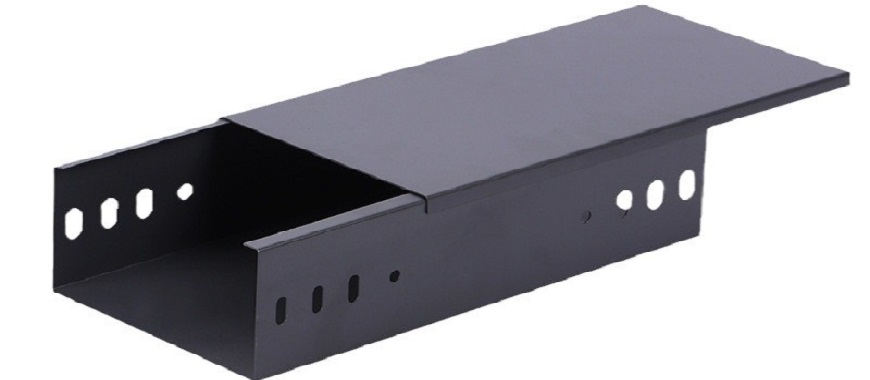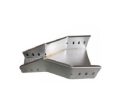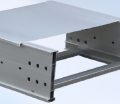
Cable and hose trays are essential components in industrial environments, providing a safe and organized method for managing cables and hoses. These trays help protect cables from damage while ensuring proper airflow, which is crucial for preventing overheating and reducing maintenance needs. Cable and hose trays come in different designs, such as basket and wire trays, each offering unique benefits based on the specific requirements of the installation. Basket trays are ideal for flexible cable routing and easy adjustments, while wire trays provide a strong structure for heavier cable loads. Choosing the right cable and hose trays ensures both efficiency and safety in facilities, enhancing the overall performance of electrical and mechanical systems.
Key Considerations for Cable and Hose Trays: Materials and Applications
Cable and hose trays are integral components of any structured cabling system, providing a safe and efficient means to route, organize, and protect cables and hoses in both industrial and commercial environments. Proper selection and installation of cable and hose trays are essential for ensuring the longevity, reliability, and performance of the entire network or machinery. In this article, we will explore the importance of cable and hose trays, their various types and materials, and considerations for installation and maintenance.
What are Cable and Hose Trays?
Cable and hose trays are designed to provide support and protection to a wide variety of cables and hoses. They are commonly used in commercial, industrial, and construction settings to manage the extensive networks of power, telecommunications, and data cables that are required for modern infrastructure. These trays are typically made from a variety of materials such as steel, aluminum, fiberglass, and plastic, each offering specific benefits depending on the application.
The main function of cable and hose trays is to keep cables organized and secure while facilitating easy access for future upgrades, maintenance, or repairs. Unlike traditional conduit systems, which often require individual routing of each cable, cable and hose trays allow multiple cables to be grouped together in a single unit. This not only improves the overall system’s organization but also reduces the risk of cable damage or interference. Additionally, cable and hose trays can be easily customized with accessories such as bends, tees, and covers to accommodate specific installation requirements.
Types of Cable and Hose Trays
There are several different types of cable and hose trays, each suited for specific types of installations and requirements. The most common types include ladder-type trays, solid-bottom trays, and wire mesh trays. Each design offers unique advantages in terms of airflow, cable access, and ease of installation.
Ladder-Type Trays
Ladder-type trays are the most widely used type of cable tray and are ideal for heavy-duty cable management. These trays consist of two side rails connected by rungs, creating a structure that resembles a ladder. The open design allows for excellent airflow around the cables, reducing the risk of overheating, which is critical in high-power cable installations. Ladder-type trays are versatile and can accommodate a wide range of cable types, from power cables to fiber optics. They are especially suitable for large installations with high cable density.
Solid-Bottom Trays
Solid-bottom trays provide a flat, enclosed surface for cable routing. These trays are often used when cables need to be completely protected from dust, dirt, or moisture. The solid surface also offers more stability for smaller cables that may be prone to shifting or becoming disorganized. Solid-bottom trays are commonly used in environments where extra protection for the cables is required, such as in industrial or outdoor applications. They are also ideal for carrying sensitive cables that need to be shielded from physical damage or environmental conditions.
Wire Mesh Trays
Wire mesh trays are lightweight, flexible, and offer a simple yet effective solution for cable management. Made from welded wire mesh, these trays are ideal for installations where flexibility and cost-effectiveness are important considerations. Wire mesh trays allow for easy adjustment and modification, making them well-suited for environments where frequent cable changes or additions are anticipated. Although they do not provide as much protection as solid-bottom trays, they offer good ventilation and are a practical solution for less sensitive cables.
Materials for Cable and Hose Trays
The choice of material for cable and hose trays depends on a variety of factors, including environmental conditions, load requirements, and budget considerations. The most common materials used for cable and hose trays are steel, stainless steel, aluminum, fiberglass, and plastic.
Steel Trays
Steel is a popular choice for cable trays due to its strength and durability. Steel trays can handle heavier loads and are commonly used in large installations that require robust support for cables. Steel trays are often coated with materials such as zinc (galvanized steel) to provide additional resistance to corrosion. However, steel trays may not be the best option for environments that are highly corrosive, such as chemical plants or outdoor installations.
Stainless Steel Trays
Stainless steel is an ideal material for cable trays used in harsh environments. The corrosion-resistant properties of stainless steel make it a superior choice for applications where exposure to moisture, chemicals, or extreme temperatures is common. Stainless steel trays are often used in food processing plants, pharmaceuticals, and offshore industries. The durability and resistance of stainless steel ensure that the trays can withstand the rigors of demanding conditions. Different grades of stainless steel are available, including 304 and 316 stainless steel, each suited for specific environmental challenges.
Aluminum Trays
Aluminum is a lightweight yet strong material often used for cable trays in applications where weight is a concern. Aluminum trays are highly resistant to corrosion, particularly in non-industrial environments. They are commonly used in both indoor and outdoor installations and are ideal for applications where ease of handling and installation is important. Aluminum trays are often used in commercial buildings, data centers, and other environments where both strength and aesthetic appeal are desired.
Fiberglass Trays
Fiberglass is an increasingly popular material for cable trays, particularly in environments that require non-metallic solutions. Fiberglass trays are resistant to corrosion, making them ideal for use in chemical plants, wastewater treatment facilities, and other corrosive environments. Additionally, fiberglass trays are non-conductive, which adds an extra layer of safety for electrical installations. At GangLong Fiberglass, we offer a wide range of fiberglass cable trays designed to meet the needs of demanding industrial applications.
Plastic Trays
Plastic cable trays are lightweight, easy to install, and resistant to many chemicals and environmental factors. They are commonly used in residential, commercial, and light industrial applications. Plastic trays are available in various grades and can be used for applications that do not require heavy-duty support. However, they are typically not as durable as steel or fiberglass trays and may not be suitable for environments where heavy loads or extreme conditions are a factor.
The Benefits of Using Cable and Hose Trays
The use of cable and hose trays in installations offers numerous benefits, particularly in terms of system organization, safety, and ease of maintenance. Here are some of the key advantages of using cable and hose trays in various applications:
Organization and Space Optimization
One of the primary benefits of using cable and hose trays is the organization they provide. Cables and hoses can be neatly arranged within the trays, reducing clutter and making it easier to manage large numbers of cables. Cable trays also allow for the efficient use of space, which is especially important in complex installations such as data centers, manufacturing facilities, and large commercial buildings.
Protection and Safety
Cable and hose trays offer a layer of protection for the cables inside. Whether it’s shielding cables from physical damage, moisture, or extreme temperatures, trays help preserve the integrity of the cables over time. In addition to protecting the cables, cable trays also contribute to the overall safety of the installation by reducing the risk of cable interference, overheating, or accidental disconnections. This is particularly important in high-voltage or sensitive environments where cable integrity is paramount.
Ease of Installation and Maintenance
Cable and hose trays are easy to install, modify, and expand. The modular nature of these systems allows for quick adjustments during the installation phase and makes future upgrades or repairs much simpler. Additionally, cable trays provide easy access to cables, which makes maintenance and troubleshooting more efficient. When cables need to be replaced, added, or repaired, the open structure of cable trays ensures that technicians can quickly identify and access the necessary cables.
Cost-Effectiveness
Installing cable and hose trays can be more cost-effective than other cable management systems, such as conduits or individual cable runs. Cable trays allow for quicker installations, less material waste, and reduced labor costs. Additionally, since cable trays are designed for easy reconfiguration, they offer long-term cost savings by accommodating future changes to the network or machinery without requiring a complete overhaul.
How to Install Cable and Hose Trays
The installation of cable and hose trays requires careful planning to ensure the system is properly aligned with the network’s needs and safety standards. Some important factors to consider during installation include the correct material choice, tray size, load-bearing capacity, and proper support brackets.
First, the layout of the cable tray system should be designed to ensure that cables can be routed efficiently and without obstruction. It’s essential to avoid sharp bends, which can damage the cables. Tray sections should be installed at appropriate intervals, using support brackets or hangers to ensure the system remains secure.
Furthermore, when working with larger installations, it’s crucial to provide access points for easy maintenance and expansion. Tray covers may be added where necessary to prevent cables from becoming exposed to environmental hazards. Finally, proper grounding of the system is necessary to prevent electrical hazards.
By following these guidelines, cable and hose trays can be effectively utilized to manage and protect cables, ensuring long-term performance and safety in any installation.
Key Requirements for Low Voltage Cable Tray Grounding
Exploring Cable and Hose Trays: Materials, Designs, and Applications
Cable and hose trays are crucial components of modern cable management systems. These trays provide a safe, organized way to route cables and hoses in industrial, commercial, and residential environments. Proper installation and material selection for cable and hose trays ensure efficient use of space, easy maintenance, and long-term protection for cables and hoses. In this article, we will dive deep into the role of cable and hose trays, exploring their designs, materials, applications, and key considerations for choosing the right tray system for your needs.
What are Cable and Hose Trays?
Cable and hose trays are designed to provide support and protection to a wide range of cables and hoses in different environments. These systems are typically installed along ceilings, walls, or floors to route cables in an organized manner. The key benefit of cable and hose trays is that they allow for flexibility, easy access, and protection of the cables, whether they are power cables, communication lines, or hoses for machinery.
The versatility of cable and hose trays makes them an essential part of infrastructure in industries ranging from telecommunications to manufacturing, construction, and energy sectors. They also offer ease of modification and expansion, which is critical in growing facilities where additional cables or hoses may need to be added in the future. By providing an open, organized space for cables, cable and hose trays eliminate the risk of cables tangling or getting damaged.
Key Benefits of Using a Trench Cable Tray System
Types of Cable and Hose Trays
Cable and hose trays are available in various materials and designs to meet the specific needs of the installation environment. The most common types of trays include ladder trays, perforated trays, and basket trays, each offering unique benefits.
Ladder-Type Trays
Ladder-type trays are one of the most widely used designs for routing cables. This type of tray consists of two side rails connected by horizontal rungs that resemble a ladder. The open structure allows for excellent airflow around the cables, which is crucial for preventing overheating, especially in high-power installations. Ladder-type trays are ideal for installations that require a large number of cables or heavy-duty usage. They are often used in both indoor and outdoor environments and can support a variety of cable types, from electrical power lines to fiber optic cables.
Perforated Trays
Perforated trays offer a similar design to ladder trays but with a solid base that features small perforations. This design provides more stability to the cables and reduces the risk of them shifting or being damaged. Perforated trays are often used when cables need extra protection from physical damage or dust. The perforations also allow for adequate ventilation, which is important for preventing the buildup of heat around the cables. Perforated trays are commonly used in environments where there are moderate environmental conditions and a need for greater cable stability.
Basket Trays
Basket trays, or wire mesh trays, offer an innovative and flexible design for routing cables. These trays consist of a wire mesh structure that is often made of steel or fiberglass. The open design allows for quick and easy cable installation, and the flexibility of the mesh allows for the addition of new cables without disrupting the existing ones. Basket trays are ideal for situations where frequent cable changes are expected, such as in data centers or telecommunications networks. The wire design also offers excellent ventilation, keeping cables cool and reducing the risk of overheating. Basket trays can be mounted on walls, ceilings, or floors, making them highly versatile in different settings.
Benefits of Using Cable and Hose Trays
There are numerous benefits to incorporating cable and hose trays into an installation. One of the key advantages is their ability to keep cables organized and protected. By using a cable and hose tray system, cables are less likely to become tangled or damaged by environmental factors. Additionally, trays help reduce the physical stress that cables are subject to during installation or maintenance.
Organization and Safety
Cable and hose trays keep cables organized by separating them into designated pathways, reducing the risk of interference between cables. This organization not only makes cables easier to maintain but also helps prevent electrical malfunctions caused by misrouted or tangled wires. Moreover, properly secured cables reduce the chances of accidental tripping hazards or physical damage to cables.
Cost-Effectiveness and Efficiency
Cable and hose trays are cost-effective solutions for managing large quantities of cables, particularly in commercial and industrial settings. Their open design makes it easier to install and manage cables compared to traditional conduit systems. The flexibility of cable and hose trays also ensures that modifications can be made with minimal downtime and disruption to ongoing operations.
Ease of Maintenance
One of the biggest advantages of cable and hose trays is the ease of access they provide for future maintenance or upgrades. When cables are routed in trays, it is much easier to replace, add, or adjust cables as needed. This reduces the need for costly and time-consuming maintenance procedures, making cable and hose tray systems a practical solution for growing systems or facilities.
Choosing Clamps for Effective B Line Cable Tray Grounding

As the editor of GangLong Fiberglass, I have years of experience and in-depth research, focusing on cable tray products, fiberglass solutions, and grille systems. I incorporate years of industry insights and practical experience into every content, committed to promoting the progress of the industry. At GangLong Fiberglass, my commitment is reflected in every product, from innovative cable trays to durable fiberglass solutions and sturdy grille systems. As an authoritative voice in the industry, my goal is to provide valuable information to professionals and businesses and promote forward-looking solutions.


